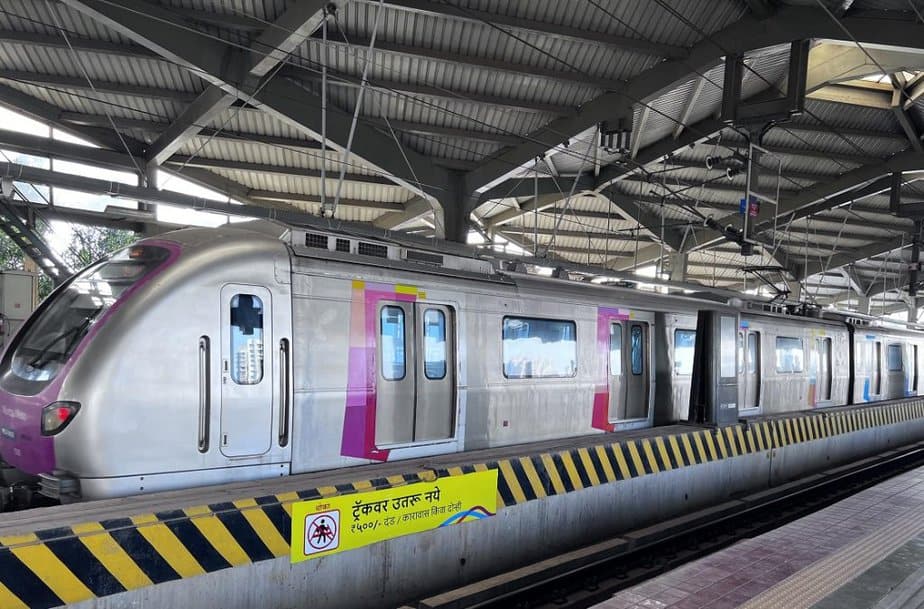
Mumbai, the bustling metropolis on the western coast of India, has evolved its transportation infrastructure to meet the demands of its ever-expanding population. The Mumbai Metro, a relatively recent addition to the city’s transit landscape, has swiftly become an integral part of daily life for countless Mumbaikars.
Let us dive into the intricacies of the Mumbai Metro, exploring its routes, station sequences, travel costs, train frequency, and the facilities it offers to commuters.
1. Line 1: Versova-Andheri-Ghatkopar (VAG) Metro Line
The first operational line of the Mumbai Metro, Line 1, commonly known as the Versova-Andheri-Ghatkopar (VAG) Metro Line, is a vital east-west corridor connecting key areas of the city. Here is a station-wise sequence:
- Versova: The westernmost point of Line 1, Versova is a bustling suburb with a vibrant atmosphere and a prominent beach.
- D.N. Nagar: This station is a crucial commuter junction, facilitating transfers between Line 1 and the upcoming Line 2A.
- Azad Nagar: Located in the Andheri region, Azad Nagar is a residential and commercial hub, contributing to the station’s significance.
- Andheri: A central transportation hub, Andheri is a bustling locality with a significant concentration of commercial and residential establishments.
- Western Express Highway (WEH): Positioned strategically for accessibility, this station aids commuters traveling along the Western Express Highway.
- Chakala (J.B. Nagar): Serving the business district of MIDC, Chakala station is essential for those working in the industrial areas nearby.
- Airport Road (Marol Naka): This station facilitates seamless connectivity for air travelers near the Chhatrapati Shivaji Maharaj International Airport.
- Saki Naka: Known for its industrial and commercial establishments, Saki Naka is a key station for the working population in the vicinity.
- Asalpha: This station serves Ghatkopar’s residential and commercial areas, contributing to the overall connectivity of the Line 1 corridor.
- Jagruti Nagar: Positioned to enhance accessibility for the local population, Jagruti Nagar station caters to the needs of commuters in the region.
- Ghatkopar: The eastern terminus of Line 1, Ghatkopar is a central suburban railway station and a commercial hub in the east part of Mumbai.
Cost of Travel:
The cost of traveling on the Mumbai Metro varies based on the distance traveled. The fare structure typically ranges from a minimum of Rs. 10 for short distances to a maximum of Rs. 40 for longer journeys. Smart cards and mobile-based ticketing options are available for convenience, offering discounts on regular fares.
Frequency of Trains:
Mumbai Metro Line 1 is known for its frequent and punctual service. During peak hours, trains run at intervals of around 4 to 5 minutes, ensuring that commuters do not face long waiting times.
Facilities Available:
- Wi-Fi Connectivity: Many stations on Line 1 provide Wi-Fi connectivity, allowing commuters to stay connected while waiting for their trains.
- Elevators and Escalators: To enhance accessibility, elevators and escalators are installed at various stations, making it easier for passengers, including those with mobility challenges.
- Parking Facilities: Some stations offer parking facilities, easing the commute for those who prefer to drive to the metro station.
2. Line 2A: Dahisar to D.N. Nagar Metro Line
Line 2A is an extension of Line 1, connecting Dahisar to D.N. Nagar. This corridor further strengthens the connectivity of the western suburbs. Here is a station-wise sequence:
- Dahisar (East): The westernmost point of Line 2A, Dahisar East station, connects the metro network to the city’s farthest reaches.
- Anand Nagar
- Kandarpada
- Mandapeshwar
- Eksar
- Borivali (West)
- Pahadi Eksar
- Kandivali (West)
- Dahanukarwadi
- Valnai (Mith Chowki)
- Malad West
- Lower Malad
- Pahadi Goregoan
- Goregaon West
- Oshiwara
- Lower Oshiwara
- D.N. Nagar: A junction connecting Lines 1 and 2A, D.N. Nagar station, is pivotal in facilitating transfers between these two major corridors.
Cost of Travel:
The cost of traveling on Line 2A is integrated with the overall Mumbai Metro fare structure, ensuring a seamless and consistent pricing system. Minimum Fare starts from Rs.10
Frequency of Trains:
Line 2A operates with a frequency similar to Line 1, ensuring commuters experience minimal waiting times, especially during peak hours. There is a train every 6 to 8 min.
Facilities Available:
- Connectivity with Other Lines: D.N. Nagar station is an interchange point, allowing commuters to transfer between Line 1 and 2A.
- Modern Station Infrastructure: Stations on Line 2A are equipped with modern amenities, including digital signage, to enhance the overall commuter experience.
3. Dashisar East to Gundavli (Andheri East)
- Dahisar East
- Ovaripada
- Rashtriya Udyan (National Park)
- Devipada
- Magathane
- Poisar (Mahindra & Mahindra)
- Akurli
- Kurar (Pushpa Park)
- Dindoshi (Pathanwadi)
- Aarey
- Goregaon E (Mahanand Dairy)
- Jogeshwari E (JVLR Junction)
- Mogra (Shankarwadi)
- Gundavali (Andheri East)
Leave a Reply